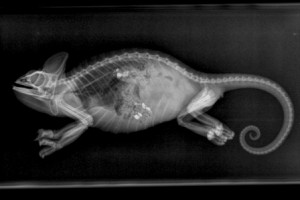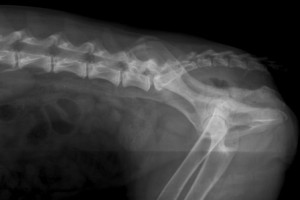 Radiology or X-rays is a commonly used diagnostic tool that uses a special machine to produce electromagnetic radiation in the form of x-rays. These x-rays pass through the body and are detected on film or special radiology plates. The amount of x-rays that pass through is affected by the type and thickness of the tissues. Using special processing an image is created to allow our veterinarians to make a diagnosis.
Radiology or X-rays is a commonly used diagnostic tool that uses a special machine to produce electromagnetic radiation in the form of x-rays. These x-rays pass through the body and are detected on film or special radiology plates. The amount of x-rays that pass through is affected by the type and thickness of the tissues. Using special processing an image is created to allow our veterinarians to make a diagnosis.
Radiology can be used to image both bones and soft tissues. Problems affecting bones such as breaks, arthritis, cancers and dislocations can all be assessed using radiographs. Soft tissue diseases such as heart enlargement, gastrointestinal foreign bodies and bladder stones can also all be diagnosed using radiology.
X-rays technology has advanced considerably and they days of x-ray films are no longer! Using highly sophisticated digital x-ray equipment images appear almost instantaneously on a computer screen. Karingal Vet Hospital was one of the first veterinary practices to embrace this new technology because very early on we saw its many benefits to the care of our patients.
These benefits include:
Additional imaging techniques utilising radiology are also available at our practices. For example, the use of special contrast agents allow for a more accurate diagnosis of many conditions such a foreign objects in the stomach or intestines.
What happens to my pet when it needs radiographs?
 Most patients that require radiographs will need to be admitted to the hospital for the day. This allows adequate time for the pet to be imaged and the veterinary staff to assess the radiographs. In the vast majority of cases the pet will be either sedated or anaesthetised to allow for the radiographs to be taken and so they need time to recover from this before going home.
Most patients that require radiographs will need to be admitted to the hospital for the day. This allows adequate time for the pet to be imaged and the veterinary staff to assess the radiographs. In the vast majority of cases the pet will be either sedated or anaesthetised to allow for the radiographs to be taken and so they need time to recover from this before going home.
Sedation or anaesthesia is required because most pets will not lie still for the procedure. Movement while the images are taken will result in blurry, non-diagnostic images. This means we have to repeat the radiographs resulting in greater exposure of your pet and our staff to x-rays. As a safety measure we try to minimise or eliminate exposure of the staff to x-rays a much as possible because over time they can have serious health consequences. Because of this our staff cannot be in the room holding your pet while the radiographs are taken.
X-rays are a safe procedure that require only a short recovery period while the anaesthesia or sedation wears off. Your pet will not suffer any complications or side effects from having an x-ray.